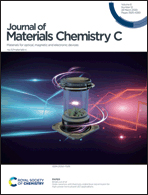Glass-ceramics with thermally stable blue-red emission for high-power horticultural LED applications†
Abstract
As one of the key elements of indoor agriculture, horticultural light sources are developing rapidly towards requiring high energy density, high output power and high stability, which poses a challenge for traditional phosphor conversion devices. To address this, an all-inorganic blue-red dual-emitting light convertor consisting of Ba1.3Sr1.7MgSi2O8:Eu2+,Mn2+ (BSMS) phosphor-in-glass (PiG) plates was prepared to improve the duration lifetime of converted high-power light-emitting diodes (LEDs) and meet the light quality requirements of photosynthesis for indoor agriculture. The obtained samples show an external quantum efficiency of 45.3%, outstanding thermal stability and a specific emission spectrum that highly matches the absorption of chlorophyll and β-carotene. Moreover, a proof-of-concept BSMS-PiG horticultural lamp for application in an indoor plant factory was successfully fabricated based on a ∼370 nm emitting LED chip. The blue-red ratio of its spectrum could be regulated by controlling the thickness of BSMS-PiG and the concentrations of Mn2+ ions within BSMS-PiG. The BSMS-PiG horticultural LEDs were applied to the indoor cultivation of Romaine lettuce. The results indicated that the biomass of Romaine lettuce was 58.21% greater than that of control lettuce samples cultivated under commercial plant lamps. In particular, the content values of total chlorophyll, β-carotene and soluble protein were improved. The BSMS-PiG horticultural LED is a potential candidate to act as a high-power horticultural light source.



 Please wait while we load your content...
Please wait while we load your content...